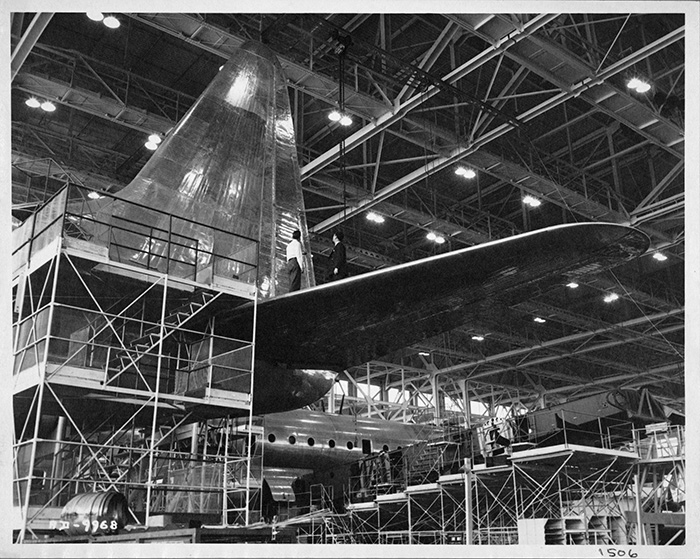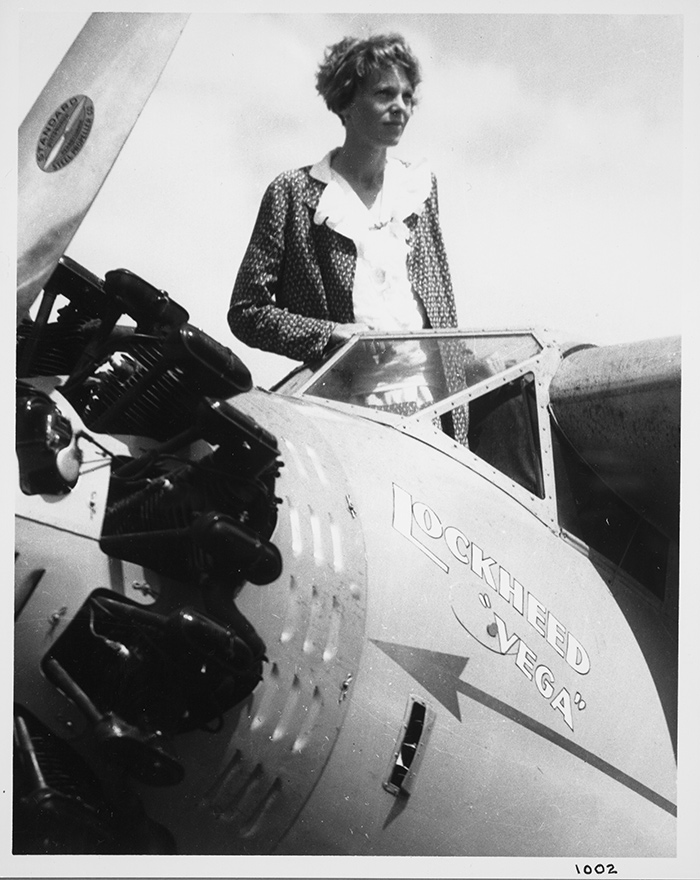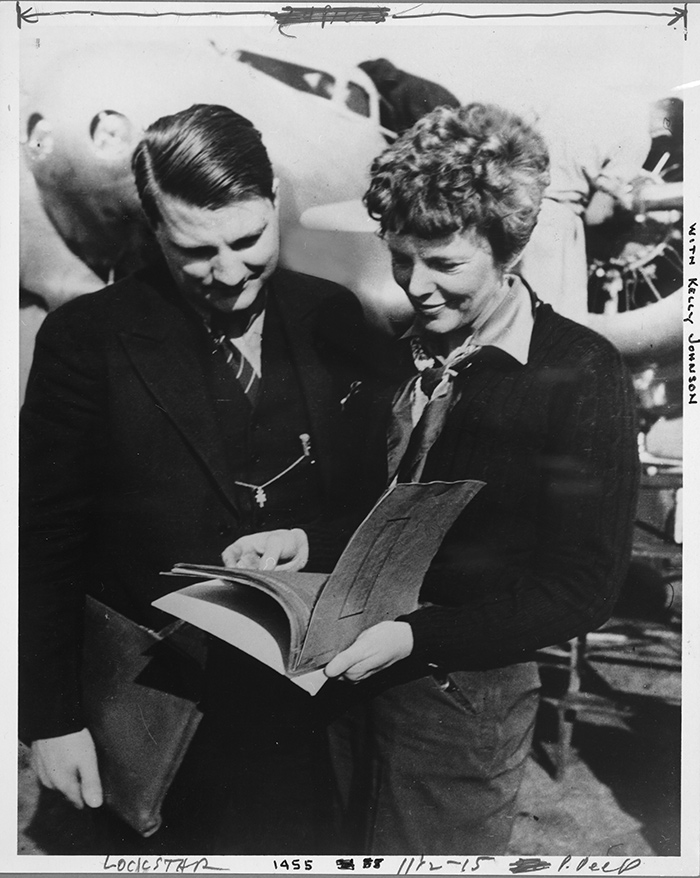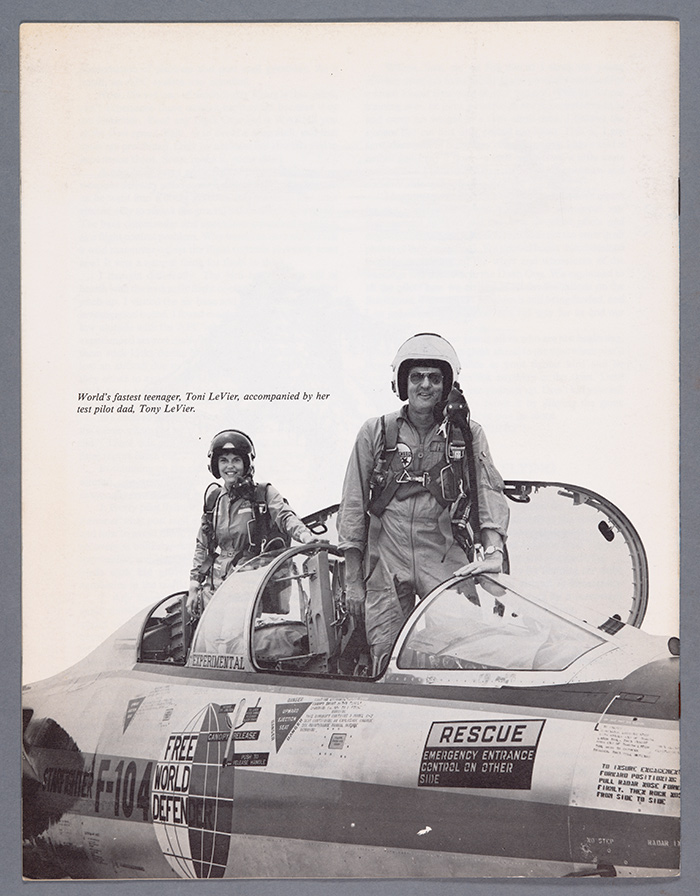The Huntington’s blog takes you behind the scenes for a scholarly view of the collections.
Flight Path
Posted on Mon., April 25, 2016 by

Lockheed R6V Constitution Aircraft under construction. Harvey Christen Collection, The Huntington Library, Art Collections, and Botanical Gardens. Harvey Christen (1910–1993), a mechanic, was one of the first employees of Lockheed Aircraft Corporation.
As part of my project “City on the Edge of Forever: Los Angeles Beyond the Screen,” I’ve been researching the aerospace industry in Southern California. I’ve been looking at its impact on everything from revolutions in the shape of surfboards to high-tech art movements of the 1960s and 1970s, including Finish Fetish and Light and Space. I’ve explored the influence of the aerospace industry on Orange County’s mix of libertarianism and traditional conservatism during Barry Goldwater’s 1964 presidential campaign and even the Oedipal struggles of 1960s Laurel Canyon rockers against their career military fathers.
The Huntington has been a pioneer in promoting this kind of research. In 2011, The Huntington mounted the exhibition “Blue Sky Metropolis: The Aerospace Century in Southern California,” featuring some of its vast collection of books, papers, and photography documenting the aerospace industry and its pioneers, and a year later published a book under the same title.
Recently, I’ve been concentrating on the Lockheed Corporation. Early on, it produced some of Amelia Earhart’s favorite planes, including the Vega, which she flew solo across the Atlantic Ocean, becoming the first woman to do so (and only the second person after Charles Lindbergh).

Amelia Earhart in her Lockheed Vega. Harvey Christen Collection, The Huntington Library, Art Collections, and Botanical Gardens.
The Huntington’s Harvey Christen collection of aerospace photography includes striking images, some unpublished, of America’s most famous aviatrix. She is seen with friends and collaborators, including engineering genius Clarence “Kelly” Johnson, who later founded Lockheed’s Advanced Development Projects in the San Fernando Valley, better known as the Skunk Works.
The Skunk Works designed and prototyped the U-2 spy plane and the SR-71 Blackbird, which flew at three times the speed of sound (Mach 3) and set speed records that still stand. Johnson was famous for his management strategy of “KISS”— Keep It Simple, Stupid—and established the very exemplar of the “California” company to come. By the 21st century, countless tech companies embraced KISS, taking risks and flattening hierarchies. Whether they actually called their dedicated labs Skunk Works, as Apple did, or camouflaged them as X Labs, as Google did, their debt to Kelly was incalculable.
Another of The Huntington’s collections features the papers of Anthony “Tony” LeVier, the first person to fly many of Johnson’s revolutionary new planes. The National Aviation Hall of Fame called LeVier “the world’s foremost experimental test pilot,” and he was the first to fly the U-2 and the prototype XF-104 Starfighter—two of the Skunk Works’ most innovative designs.

Amelia Earhart and Kelly Johnson. Harvey Christen Collection, The Huntington Library, Art Collections, and Botanical Gardens.
One of my favorite finds in the LeVier papers is a shot of him and his teenaged daughter Toniann in a two-seater supersonic Starfighter, complete with a decal on the fuselage that reads: “FREE WORLD DEFENDER.” The photographer caught father and daughter on the tarmac during a promotional tour from California to Washington, D.C., in May of 1963. Between promotional stops, Toniann switched seats with her dad and cranked the plane up to Mach 2 over the Mojave Desert, a feat that got her labeled “America’s fastest teenager” by Parade magazine. I’ve seen photos elsewhere of LeVier that show him with his test-pilot face on, all attitude and aviator shades. In The Huntington’s photo, however, he’s smiling broadly, a father proud of his kid, all of 19 at the time, decked out in a custom-tailored flight suit.
Serendipity is not usually acknowledged as part of the scholarly process, but it happens occasionally, and in this case, made me feel that my research on the aerospace industry was on track. I was waiting to pick up my own daughter from Los Angeles International Airport. Killing time, I stopped off in nearby Westchester. As I walked back to my car along Sepulveda Boulevard, I looked down and realized that I was following the Flight Path Museum’s Walk of Fame. And there it was—I had parked right next to the star belonging to test pilot Tony LeVier.

Detail of the back cover of Hangar Flying, Issue 1 (July 1985). Anthony LeVier Papers, The Huntington Library, Art Collections, and Botanical Gardens.
You can read more about The Huntington’s aerospace collections in the Spring/Summer 2010 issue of Huntington Frontiers.
Related content on Verso:
Down to Earth (Aug. 8, 2012)
On the Calculus of Hanging Ten (Jan. 5, 2012)
How the West Won Me Over (Dec. 15, 2011)
Over the Moon (Nov. 21, 2011)
Beyond the Numbers (Oct. 19, 2011)
Blue Skies that Launched an Industry (July 8, 2011)
Peter Lunenfeld is the 2015-16 Dana and David Dornsife Fellow at The Huntington, a professor of Design Media Arts at UCLA, and a member of the UCLA Digital Humanities and Urban Humanities faculties. His recent books include The Secret War Between Downloading and Uploading (MIT Press, winner of the 2013 Dorothy Lee Prize) and Digital_Humanities (MIT Press, co-authors, Anne Burdick, Johanna Drucker, Todd Presner, and Jeffrey Schnapp).